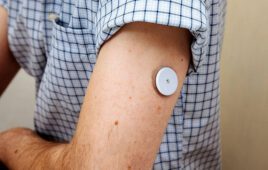
An at-home monitoring system could help monitor Parkinson’s progression and response to medication. [Image by N.Fuller/SayoStudio]
Collecting data at home could help provide a less subjective measurement than evaluations at the doctor’s office, which can be affected by outside factors. The technology could also help pharmaceutical and biotech companies developing new therapies for Parkinson’s, which is the world’s fastest-growing neurological disease.
In a one-year study with 50 patients, machine learning algorithms analyzed the data to help clinicians track Parkinson’s progression and medication response more effectively than periodic evaluations in a medical facility, MIT said in a news release. The study fund that gait speed declined nearly two times faster for people with Parkinson’s than those without.
The study was published yesterday in Science Translational Medicine.
“By being able to have a device in the home that can monitor a patient and tell the doctor remotely about the progression of the disease, and the patient’s medication response so they can attend to the patient even if the patient can’t come to the clinic — now they have real, reliable information — that actually goes a long way toward improving equity and access,” senior author Dina Katabi said in the release.
Katabi is the Thuan and Nicole Pham Professor in the Department of Electrical Engineering and Computer Science and a principal investigator in the Computer Science and Artificial Intelligence Laboratory (CSAIL) and the MIT Jameel Clinic. EECS graduate students Yingcheng Liu and Guo Zhang we co-lead authors.
How the Parkinson’s progression device works
The device is about the size of a wi-fi router and constantly monitors a patient’s movement and gait speed, data that can be used to evaluate Parkinson’s progression and the severity of their disease, as well as the patient’s response to medication.
The device sits in the home and reflects radio signals off the patient as they move about. The super-low-power signals pass through solid objects and walls, but bounce off people due to the water in our bodies. The device’s machine-learning classifier can track the patient among other people.
“Monitoring the patient continuously as they move around the room enabled us to get really good measurements of their gait speed,” Zhang said in the release. “And with so much data, we were able to perform aggregation that allowed us to see very small differences.”
In the study, daily changes in a patient’s gait matched medication responses, with walking speed increasing after meds and declining as they wear off.
“This enables us to objectively measure how your mobility responds to your medication,” Liu said in the release. “Previously, this was very cumbersome to do because this medication effect could only be measured by having the patient keep a journal.”
The research team could use similar at-home devices to study Alzheimer’s, ALS and Huntington’s, and is exploring ways to apply related research on monitoring breathing to diagnose Parkinson’s.
“This radio-wave sensor can enable more care (and research) to migrate from hospitals to the home where it is most desired and needed,” co-author and University of Rochester Medical Center neurology professor Ray Dorsey said in the release. “Its potential is just beginning to be seen. We are moving toward a day where we can diagnose and predict disease at home. In the future, we may even be able to predict and ideally prevent events like falls and heart attacks.”
MIT researchers have previously studied how to monitor Parkinson’s disease progression using a patient’s interactions with a computer keyboard.




